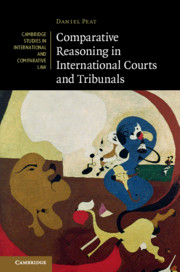Book contents
- Comparative Reasoning in International Courts and Tribunals
- Cambridge Studies in International and Comparative Law: 145
- Comparative Reasoning in International Courts and Tribunals
- Copyright page
- Contents
- Foreword
- Preface
- Table of Cases
- Table of Treaties
- Abbreviations
- 1 Introduction
- 2 The Limits of the Vienna Convention
- 3 Domestic Law in the Jurisprudence of the International Court of Justice
- 4 The Interpretation of Schedules of Commitments in the WTO
- 5 International Investment Law and the Public Law Analogy
- 6 Consensus Doctrine in the European Court of Human Rights
- 7 Domestic Law and System Building in the ICTY
- 8 Conclusion
- Bibliography
- Index
- Cambridge Studies in International and Comparative Law
3 - Domestic Law in the Jurisprudence of the International Court of Justice
Published online by Cambridge University Press: 24 May 2019
- Comparative Reasoning in International Courts and Tribunals
- Cambridge Studies in International and Comparative Law: 145
- Comparative Reasoning in International Courts and Tribunals
- Copyright page
- Contents
- Foreword
- Preface
- Table of Cases
- Table of Treaties
- Abbreviations
- 1 Introduction
- 2 The Limits of the Vienna Convention
- 3 Domestic Law in the Jurisprudence of the International Court of Justice
- 4 The Interpretation of Schedules of Commitments in the WTO
- 5 International Investment Law and the Public Law Analogy
- 6 Consensus Doctrine in the European Court of Human Rights
- 7 Domestic Law and System Building in the ICTY
- 8 Conclusion
- Bibliography
- Index
- Cambridge Studies in International and Comparative Law
Summary
Of the courts and tribunals surveyed in this book, those that deal with inter-state disputes have been most reticent to invoke domestic law to interpret international law. Some commentators have suggested that this may be due to a concern of bias towards the cited countries, a remark that certainly seems to have weight and perhaps explains why the courts and tribunals examined in this and the following chapter have tightly circumscribed their reference to domestic law, generally limiting the cited law to the parties to the case at hand.
However, other factors would also seem to distinguish inter-state courts and tribunals from those examined in subsequent chapters. The most obvious of these is the weaker analogy between domestic law and international law related to inter-state affairs, insofar as the latter aims to regulate the actions of states, not individuals. Whilst international criminal law, human rights law and international investment law arguably have clear parallels with domestic criminal law, constitutional law and public and administrative law, respectively, the rules regulating inter-state conduct have traditionally been analogised to domestic private law, especially to the law of contracts and trusts, and more recently to constitutional and public law. Yet, there are evident limits to how far these analogies are applicable to inter-state relations.
This chapter and the following chapter explore the use of domestic law by two inter-state courts and tribunals. This chapter examines the jurisprudence of the International Court of Justice (ICJ), whilst the following chapter analyses the case law of the panels and Appellate Body of the World Trade Organization (WTO). Although the cases examined vary significantly in terms of subject matter, certain common themes are identifiable. In particular, the relatively rare instances in which domestic law has been used raise questions regarding the circumstances in which domestic law may indicate the intention of a state.
- Type
- Chapter
- Information
- Publisher: Cambridge University PressPrint publication year: 2019



